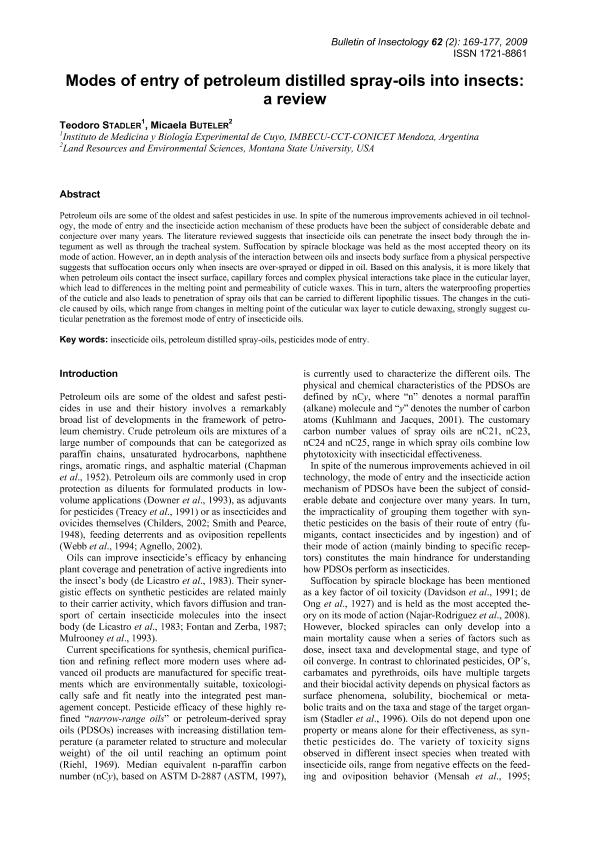Mostrar el registro sencillo del ítem
dc.contributor.author
Stadler, Teodoro

dc.contributor.author
Buteler, Micaela

dc.date.available
2019-08-08T20:13:43Z
dc.date.issued
2009-12
dc.identifier.citation
Stadler, Teodoro; Buteler, Micaela; Modes of entry of petroleum distilled spray-oils into insects: a review; Department of Agroenvironmental Sciences and Technologies; Bulletin of Insectology; 62; 2; 12-2009; 169-177
dc.identifier.issn
1721-8861
dc.identifier.uri
http://hdl.handle.net/11336/81261
dc.description.abstract
Petroleum oils are some of the oldest and safest pesticides in use. In spite of the numerous improvements achieved in oil technology, the mode of entry and the insecticide action mechanism of these products have been the subject of considerable debate and conjecture over many years. The literature reviewed suggests that insecticide oils can penetrate the insect body through the integument as well as through the tracheal system. Suffocation by spiracle blockage was held as the most accepted theory on its mode of action. However, an in depth analysis of the interaction between oils and insects body surface from a physical perspective suggests that suffocation occurs only when insects are over-sprayed or dipped in oil. Based on this analysis, it is more likely that when petroleum oils contact the insect surface, capillary forces and complex physical interactions take place in the cuticular layer, which lead to differences in the melting point and permeability of cuticle waxes. This in turn, alters the waterproofing properties of the cuticle and also leads to penetration of spray oils that can be carried to different lipophilic tissues. The changes in the cuticle caused by oils, which range from changes in melting point of the cuticular wax layer to cuticle dewaxing, strongly suggest cuticular penetration as the foremost mode of entry of insecticide oils.
dc.format
application/pdf
dc.language.iso
eng
dc.publisher
Department of Agroenvironmental Sciences and Technologies
dc.rights
info:eu-repo/semantics/openAccess
dc.rights.uri
https://creativecommons.org/licenses/by-nc-sa/2.5/ar/
dc.subject
Insecticide Oils
dc.subject
Pesticides
dc.subject
Mode of Entry
dc.subject
Petroleum Distillated Spray-Oils
dc.subject.classification
Zoología, Ornitología, Entomología, Etología

dc.subject.classification
Ciencias Biológicas

dc.subject.classification
CIENCIAS NATURALES Y EXACTAS

dc.title
Modes of entry of petroleum distilled spray-oils into insects: a review
dc.type
info:eu-repo/semantics/article
dc.type
info:ar-repo/semantics/artículo
dc.type
info:eu-repo/semantics/publishedVersion
dc.date.updated
2019-06-10T21:24:16Z
dc.journal.volume
62
dc.journal.number
2
dc.journal.pagination
169-177
dc.journal.pais
Italia

dc.journal.ciudad
Bologna
dc.description.fil
Fil: Stadler, Teodoro. Consejo Nacional de Investigaciones Científicas y Técnicas. Centro Científico Tecnológico Conicet - Mendoza. Instituto de Medicina y Biología Experimental de Cuyo; Argentina
dc.description.fil
Fil: Buteler, Micaela. Consejo Nacional de Investigaciones Científicas y Técnicas. Centro Científico Tecnológico Conicet - Mendoza. Instituto de Medicina y Biología Experimental de Cuyo; Argentina
dc.journal.title
Bulletin of Insectology
dc.relation.alternativeid
info:eu-repo/semantics/altIdentifier/url/http://www.bulletinofinsectology.org/pdfarticles/vol62-2009-169-177stadler.pdf
Archivos asociados
